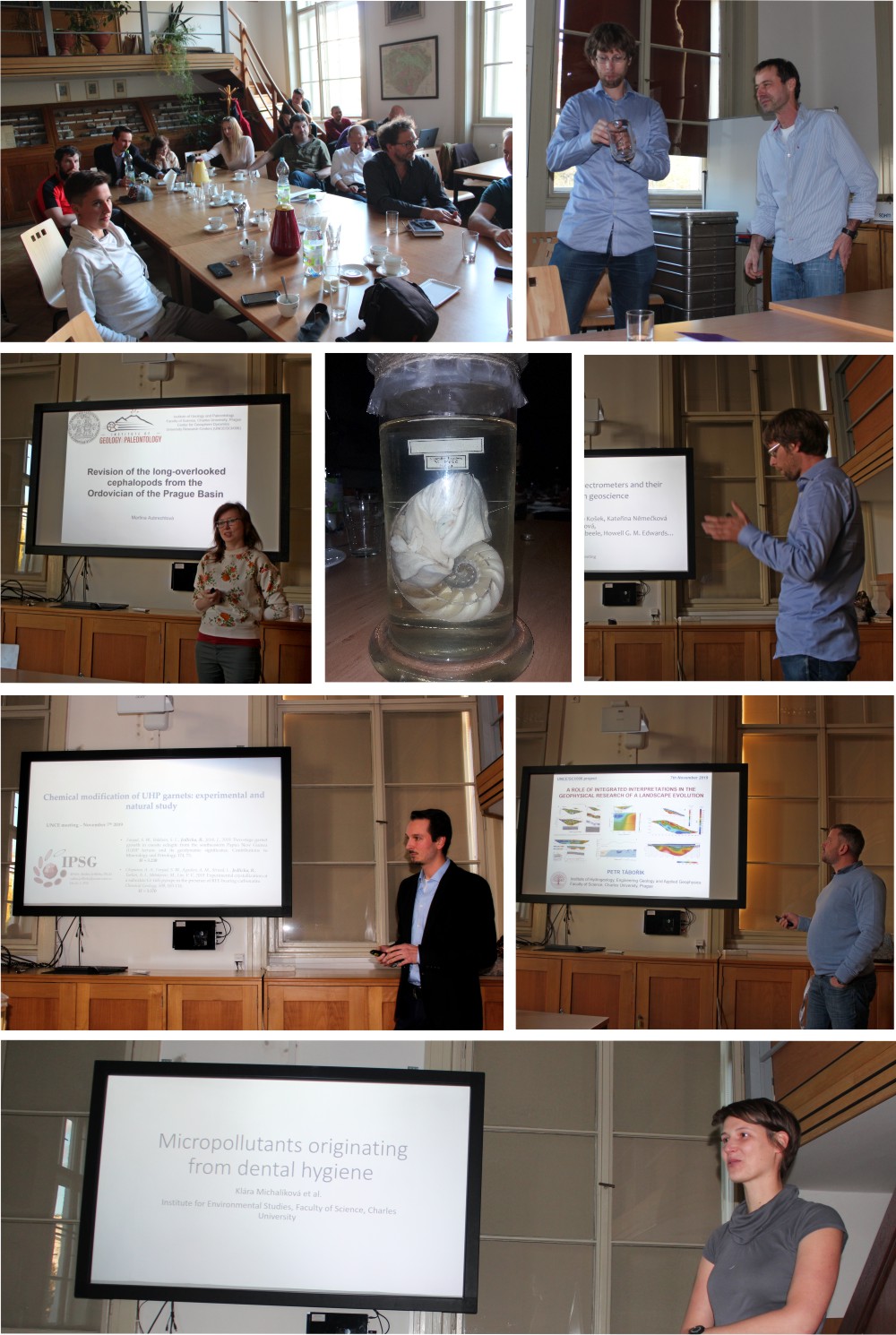 Karen Hudson-Edwards, Professor in Sustainable Mining at University of Exeter (UK), will give a lecture entitled „Environmental Minerals: Bacteria, Worms, Dusts, Toxins and the Human Body“ on Monday 13th January 2020 at 3 pm in Ložiskové sbírky (room no. 120, Albertov 6 building, Faculty of Science, Charles University). The lecture takes part of the European Association of Geochemistry Lecture Tour and is partly supported by Center for Geosphere Dynamics. You are cordially invited!
Karen Hudson-Edwards, Professor in Sustainable Mining at University of Exeter (UK), will give a lecture entitled „Environmental Minerals: Bacteria, Worms, Dusts, Toxins and the Human Body“ on Monday 13th January 2020 at 3 pm in Ložiskové sbírky (room no. 120, Albertov 6 building, Faculty of Science, Charles University). The lecture takes part of the European Association of Geochemistry Lecture Tour and is partly supported by Center for Geosphere Dynamics. You are cordially invited!
A microdestructive method using dye-coated-probe to visualize capillary, diffusion and evaporation zones in porous materials
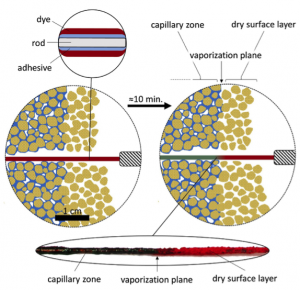 This paper presented a new field method for measuring the depth of the vaporization plane below surface of porous materials. The measuring device consisting of a rod, adhesive, and a water-soluble dye is placed into a porous material. As the pore water dissolves the dye, thus changing the device’s appearance, the dry and wet zones inside of the material can be visually distinguished. The suggested method is minimally destructive as it can be used in holes as small as 2 mm in diameter, relatively fast (typical measurement takes 10 min), and cost-effective compared to other available methods. We have conducted >500 measurements on a range of compact materials (sandstone, arkose, tuff, rhyolite), mostly on natural outcrops in humid continental, warm and cold semi-arid, and desert climates. It has been also shown that the method can find use in studying water presence in building materials or soil. We believe the method will give the scientific community a whole new perspective of water distribution especially in the near sub-surface of porous rocks for studying salt and cavernous weathering, lithophilic organisms, or water dynamics in both natural and artificial porous materials.
This paper presented a new field method for measuring the depth of the vaporization plane below surface of porous materials. The measuring device consisting of a rod, adhesive, and a water-soluble dye is placed into a porous material. As the pore water dissolves the dye, thus changing the device’s appearance, the dry and wet zones inside of the material can be visually distinguished. The suggested method is minimally destructive as it can be used in holes as small as 2 mm in diameter, relatively fast (typical measurement takes 10 min), and cost-effective compared to other available methods. We have conducted >500 measurements on a range of compact materials (sandstone, arkose, tuff, rhyolite), mostly on natural outcrops in humid continental, warm and cold semi-arid, and desert climates. It has been also shown that the method can find use in studying water presence in building materials or soil. We believe the method will give the scientific community a whole new perspective of water distribution especially in the near sub-surface of porous rocks for studying salt and cavernous weathering, lithophilic organisms, or water dynamics in both natural and artificial porous materials.
Weiss T., Mareš J., Slavík M., Bruthans J. (2020): A microdestructive method using dye-coated-probe to visualize capillary, diffusion and evaporation zones in porous materials. Science of The Total Environment 704, 135339 (DOI)
The 2019 publication statistics
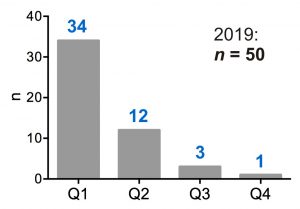 In 2019 a total of 50 papers have been published by the Center for Geosphere Dynamics in impacted journals (printed + in press). Papers published in the first and second quartile journals according to Web of Knowledge account for 92% of the total.
In 2019 a total of 50 papers have been published by the Center for Geosphere Dynamics in impacted journals (printed + in press). Papers published in the first and second quartile journals according to Web of Knowledge account for 92% of the total.
The Štramberk Limestone: Early Cretaceous world under a magnifying glass
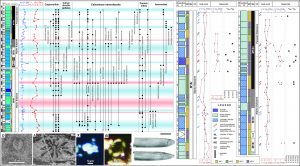 A unique exposure of the Štramberk Limestone in the Kotouč quarry was investigated by multidisciplinary approaches to clarify the age and paleoenvironmental conditions. Integrated stratigraphy (magnetostratigraphy, 87Sr/86Sr isotopes from belemnites, δ18O and δ13C stable isotopes from bulk rock, microfossil and ammonite assemblages) revealed an early Berriasian age and refused the presence of the Jurassic/Cretaceous boundary interval. The δ18O isotope signal from bulk rock together with microfossils distribution (calpionellids, calcareous nannofossils) show temperature oscillations throughout the studied successions. Boreal influences were detected by ammonites, supporting also climatic variations within the earliest Cretaceous. The limestone microfacies then revealed that all parts of a carbonate reef have been preserved in the quarry: slope, platform margin reefs, sand shoals, and possibly also patch-reefs in the inner platform.
A unique exposure of the Štramberk Limestone in the Kotouč quarry was investigated by multidisciplinary approaches to clarify the age and paleoenvironmental conditions. Integrated stratigraphy (magnetostratigraphy, 87Sr/86Sr isotopes from belemnites, δ18O and δ13C stable isotopes from bulk rock, microfossil and ammonite assemblages) revealed an early Berriasian age and refused the presence of the Jurassic/Cretaceous boundary interval. The δ18O isotope signal from bulk rock together with microfossils distribution (calpionellids, calcareous nannofossils) show temperature oscillations throughout the studied successions. Boreal influences were detected by ammonites, supporting also climatic variations within the earliest Cretaceous. The limestone microfacies then revealed that all parts of a carbonate reef have been preserved in the quarry: slope, platform margin reefs, sand shoals, and possibly also patch-reefs in the inner platform.
Vaňková L., Elbra T., Pruner P., Vašíček Z., Skupien P., Reháková D., Schnabl P., Košťák M., Švábenická L., Svobodová A., Bubík M., Mazuch M., Čížková K., Kdýr Š. (2019): Integrated stratigraphy and palaeoenvironment of the Berriasian peri-reefal limestones at Štramberk (Outer Western Carpathians, Czech Republic). Palaeogeography, Palaeoclimatology, Palaeoecology 532, 109256. (DOI)
Mesozoic paleogeography of the northern Bohemian Massif revisited
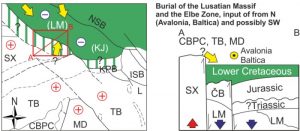 Since the pioneering works of early 20th century, Late Cretaceous sandstones along the Lusatian Fault were interpreted as sourced from the West Sudetic Island. However, the original concept that basement of the Lusatian Block directly supplied a clastic material to the Late Cretaceous shores and deltas, has been recently challenged. New LA-ICP-MS U–Pb dating of detrital zircons and heavy mineral analysis of Permian, Jurassic, and Upper Cretaceous formations revealed diachronous basin formation and subsequent inversion by reactivation of major faults in the northern Bohemian Massif. In turn, the Middle Jurassic–Early Cretaceous sedimentary cover of the Lusatian Block was redeposited by its later uplift and unroofing. This paper proves that the Bohemian Creatceous Basin is not only an excellent archive of paleoclimate changes, but its record may contribute to deciphering relatively enigmatic post-early Permian tectonosedimentary history of the surrounding basement areas.
Since the pioneering works of early 20th century, Late Cretaceous sandstones along the Lusatian Fault were interpreted as sourced from the West Sudetic Island. However, the original concept that basement of the Lusatian Block directly supplied a clastic material to the Late Cretaceous shores and deltas, has been recently challenged. New LA-ICP-MS U–Pb dating of detrital zircons and heavy mineral analysis of Permian, Jurassic, and Upper Cretaceous formations revealed diachronous basin formation and subsequent inversion by reactivation of major faults in the northern Bohemian Massif. In turn, the Middle Jurassic–Early Cretaceous sedimentary cover of the Lusatian Block was redeposited by its later uplift and unroofing. This paper proves that the Bohemian Creatceous Basin is not only an excellent archive of paleoclimate changes, but its record may contribute to deciphering relatively enigmatic post-early Permian tectonosedimentary history of the surrounding basement areas.
Nádaskay R., Žák J., Sláma J., Sidorinová T., Valečka J. (2019): Deciphering the Late Paleozoic to Mesozoic tectonosedimentary evolution of the northern Bohemian Massif from detrital zircon geochronology and heavy mineral provenance. International Journal of Earth Sciences 108, 2653-2681. (DOI)
Photos from the autumn 2019 meeting
Autumn 2019 meeting of the Center
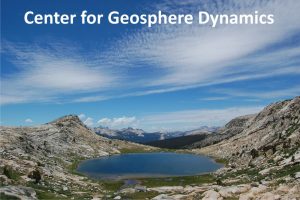 The autumn meeting of the Center for Geosphere Dynamics will take place on Thursday November 7, 2019 at 2 pm in Ložiskové sbírky room, Albertov 6, Faculty of Science. Researchers and PhD students as well as other colleagues are cordially invited. Detailed program of the seminar is available here.
The autumn meeting of the Center for Geosphere Dynamics will take place on Thursday November 7, 2019 at 2 pm in Ložiskové sbírky room, Albertov 6, Faculty of Science. Researchers and PhD students as well as other colleagues are cordially invited. Detailed program of the seminar is available here.
A “fossil” giant submarine slide discovered in the Bohemian Massif
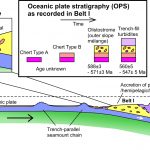 An intriguing example of a late Precambrian chert-graywacke mélange was explored by Jaroslava Hajná and colleagues in the central Bohemian Massif (mélanges are chaotic rock units that contain mixed exotic blocks and typically form along the active plate margins). A detailed field, geochronologic, and geochemical study revealed two types of chert (pelagic and those with a terrigenous component) that were mixed together during a large-scale submarine slide on an outer slope of oceanic trench. This case turned out as a quite unusual deep-marine succession and led to a definition of a new type of mélange. Published in a special issue of Gondwana Research devoted to the 100th anniversary of the inception of the mélange concept!
An intriguing example of a late Precambrian chert-graywacke mélange was explored by Jaroslava Hajná and colleagues in the central Bohemian Massif (mélanges are chaotic rock units that contain mixed exotic blocks and typically form along the active plate margins). A detailed field, geochronologic, and geochemical study revealed two types of chert (pelagic and those with a terrigenous component) that were mixed together during a large-scale submarine slide on an outer slope of oceanic trench. This case turned out as a quite unusual deep-marine succession and led to a definition of a new type of mélange. Published in a special issue of Gondwana Research devoted to the 100th anniversary of the inception of the mélange concept!
Hajná J., Žák J., Ackerman L., Svojtka M., Pašava J. (2019): A giant late Precambrian chert-bearing olistostrome discovered in the Bohemian Massif: a record of Oceanic Plate Stratigraphy (OPS) disrupted by mass-wasting along an outer trench slope. Gondwana Research 74, 173-188. (DOI)
Microbial sulfidogenesis of arsenic in naturally contaminated wetland soil
 Our investigation was situated in the natural geochemical arsenic anomaly at Smolotely-Líšnice Au district (Central Bohemia). Using the combination of geochemical (bulk soil and pore water analyses, selective chemical extractions, S isotopes), mineralogical (XRD, TEM, SEM/EDS) and biological (DNA extraction) methods we characterized massive accumulations of authigenic arsenic and iron sulfides (realgar, bonazziite, pyrite and greigite) on the fragments of organic matter that were buried in the shallow wetland soil. We have shown that by the development of suitable conditions of sulfidogenesis (very fast microbial sulfate reduction vs. slow transfer of solutes), fragments of organic matter may play an active role in arsenic immobilization in wetland systems.
Our investigation was situated in the natural geochemical arsenic anomaly at Smolotely-Líšnice Au district (Central Bohemia). Using the combination of geochemical (bulk soil and pore water analyses, selective chemical extractions, S isotopes), mineralogical (XRD, TEM, SEM/EDS) and biological (DNA extraction) methods we characterized massive accumulations of authigenic arsenic and iron sulfides (realgar, bonazziite, pyrite and greigite) on the fragments of organic matter that were buried in the shallow wetland soil. We have shown that by the development of suitable conditions of sulfidogenesis (very fast microbial sulfate reduction vs. slow transfer of solutes), fragments of organic matter may play an active role in arsenic immobilization in wetland systems.
Knappová M., Drahota P., Falteisek L., Culka A., Penížek V., Trubač J., Mihaljevič M., Matoušek T. (2019): Microbial sulfidogenesis of arsenic in naturally contaminated wetland soil. Geochimica et Cosmochimica Acta 267, 33-50. (DOI)
Filip Scheiner successfully defended his Ph.D. thesis
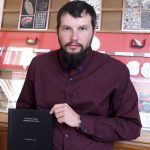 On Friday September, 27th, Filip Scheiner successfully defended his Ph.D. thesis entitled “Geochemical markers from foraminiferal tests as a tool for reconstruction of paleoceanological environments: a case study from the Miocene of the Central Paratethys” (advisor K. Holcová). His Ph.D. research resulted in four papers in highly ranked international journals. Filip will continue as a Junior Researcher affiliated with UNCE. Congratulations!
On Friday September, 27th, Filip Scheiner successfully defended his Ph.D. thesis entitled “Geochemical markers from foraminiferal tests as a tool for reconstruction of paleoceanological environments: a case study from the Miocene of the Central Paratethys” (advisor K. Holcová). His Ph.D. research resulted in four papers in highly ranked international journals. Filip will continue as a Junior Researcher affiliated with UNCE. Congratulations!









